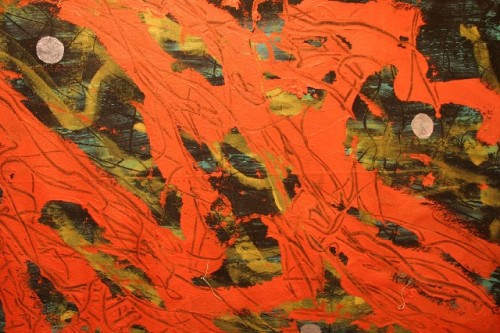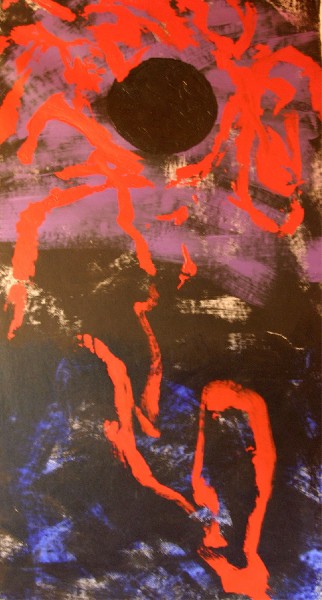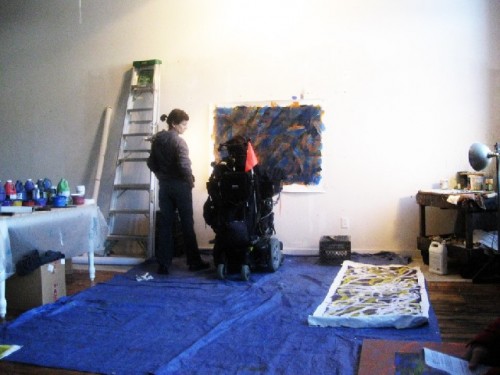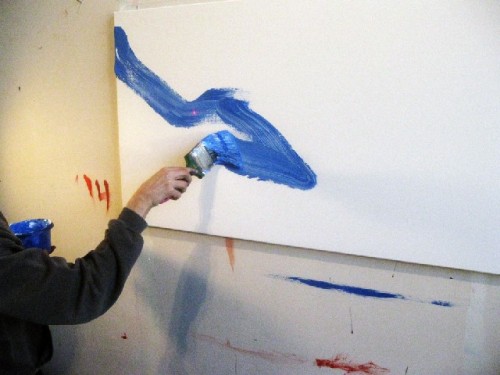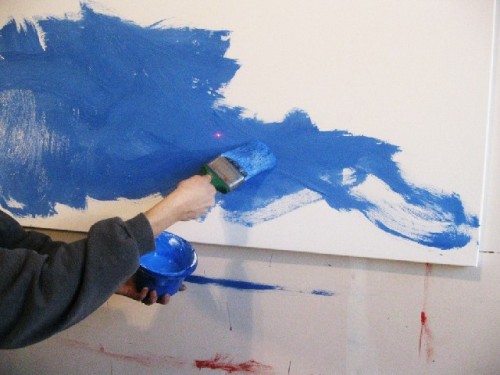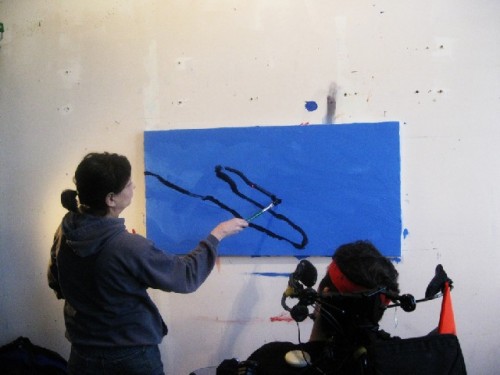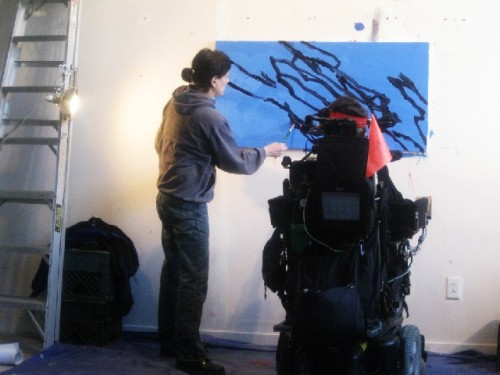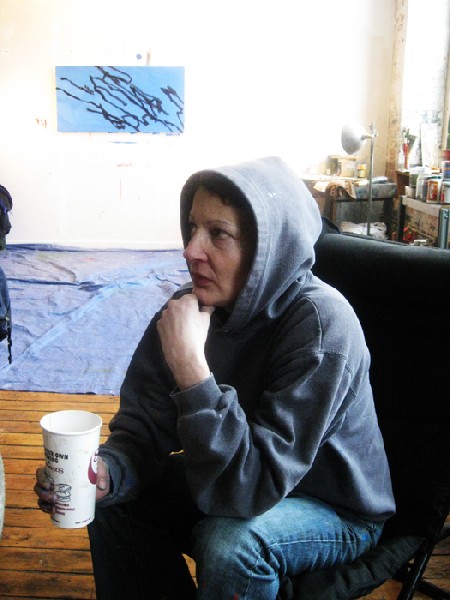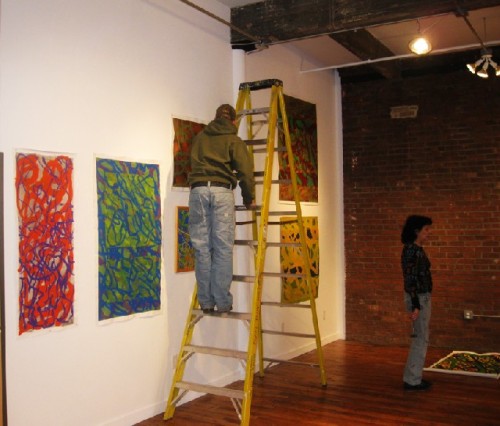The Art of A.J. Schlesinger
Eclipse Gallery Exhibition Feb.19 to March 20
By: Charles Giuliano - Feb 13, 2010
The Art of A.J. Schlesinger
Curated by Julie Seitel
The Eclipse Mill Gallery
243 Union Street
North Adams, Mass. 01247
February 19 through March 20, 2010
Opening Reception: Friday, February 19, from 6 to 8 PM
Gallery Hours: Saturday and Sunday from 12 to 5 PM
http://www.eclipsemillgallery.com
The paintings of A.J. Schlesinger, a Williamstown based artist with Cerebral Palsy, first came to my attention during the annual Berkshire Salon hosted by the Eclipse Mill Gallery in the 40 unit studio building in North Adams.
The concept of the Salon, which opens the season on Memorial Day weekend, is that any artist, for the modest fee of $15, may submit work. This results in a dense and eclectic exhibition. The non juried show is also effective in casting a wide net. There are often unique discoveries of artists who are then included in special exhibitions at the Eclipse. The work also comes to the attention of other curators and gallerists.
There are always wonderful surprises in the Salon. In that sense the first encounter with A.J. was truly remarkable and has proved to be enduring. The abstract expressionist painting, on a fairly large scale, more than held its own. I was floored to discover that it had been created by a teenager (now 20) who is unable to speak or move his arms and legs. He is able to communicate, rather slowly, through a computerized, voice synthesizer device called a Dynavox. With head movements against a sensor pad he is able to work through a menu of basic commands and responses.
For the past six years he has been working regularly with a Tracker, his former teacher at Mount Greylock Regional High School, Jane Ellen DeSomma. Usually, this entails sessions within the confines of his bedroom with barely adequate lighting. He is legally blind and could wear glasses but that would restrict head movements and communication.
The artists on the Eclipse Gallery Committee have truly embraced A.J. and Jane Ellen. The former chair, Brian Handspicker, helped to write a grant which was turned down. DeSomma expressed considerable frustration over the general difficulty and lack of support for her efforts with A.J. and several other students with special needs.
During the off season, Julie Seitel, proposed to organize a residence at the Eclipse that would culminate in an exhibition. An artist resident, Rick Harlow, who planned to be away on a research trip, generously offered the use of his studio. For the past several weeks, A.J. and Jane Ellen have been working together three days a week. They have created ten new paintings bringing the oeuvre to some 60 paintings.
A selection of about half of his output will be exhibited in the Eclipse Gallery from February 19 through March 20. The gallery will be open on Saturday and Sunday from 12 to 5 PM. Eclipse artists volunteer time to sit but A.J. will be present much of the time. He loves to have people see the work and to interact with visitors. There will be a reception for the artist on Friday, February 19, from 6 to 8 PM.
To learn more about the artist and the process of working with his Tracker I was invited to attend one of the sessions. Julie also attended and served as an intermediary and facilitator.
Before they started Jane Ellen provided a brief overview of the working process. She also expressed concerns and limitations. She was emphatic that I understand that A.J. is an art student who is still developing. There is a teaching process. All of the decisions as to color, size, and placement of brush strokes are discussed. She presents options and expresses critical evaluations but all of the decisions are those of the artist.
Several years ago she wrote a grant to invite Artist Realization Technologies to visit her school and train Trackers. The organization was founded by Tim Lefens who wrote the book Flying Colors. "It is about his experience of going to hospitals," she explained. " He's an artist who went to residential hospitals to work with handicapped patients. He has a degenerative eye disease and is now blind. When I met him he could see a little. He saw people being treated like babies and imbeciles. When he talked about art he saw fire in their eyes. He decided to devote himself to figuring out a way to unleash their creativity. They go around the country to do tracker t training. I was trained twice. It's real basic. It requires a lot of patience, objectivity and quite frankly devotion. Something like this could easily become collaboration but that is not what it is."
In what sense is their work together not collaboration? "Because the artist is asked yes or no questions" she explained. "That encompasses everything; including size, color, intensity, and specific artistic choices. This is done, for instance, when mixing color. The artist chooses a particular color. You always follow up with are you sure? One girl I worked with has the intellect of a younger child. She had a history of traumatic abuse as a baby. She was very submissive. She always chose the last thing that was said. You have to be very sure. Is this what you want? You have to be very careful."
We talked again after the session. It was insightful and poignant to observe how they interact. At times there was some frustration when A.J. became fatigued or off track. He even teased her. She interacted with these distractions patiently but with firmness and warmth. Part of her challenge is to keep him focused on the vast range of decisions and movements involved with the work.
While Jane Ellen insists that A.J. is the artist, and that she is executing his commands, it is also evident that she is a subtle and skillful painter. It may be his command but her touch and skill makes a difference. She is also a wonderful teacher and there is a lot of critical dialogue as they work.
In my book, Jane Ellen is an artist, teacher, advocate, activist, and well, Saint. Actually, God plays a role in this wonderful and dedicated work. As an aside she revealed an anecdote about her own life. She wanted very much to conceive and the biological clock was ticking. While alone in the forest she prayed. The miracle happened and she is the mother of an eight year old daughter. In gratitude she has vowed to devote her life to the service of others. "My time will come" she said. "I am a trained artist and want to do my own work some day. When my daughter is older."
She vented some frustration much of it off the record. One would think that there is support for such remarkable efforts. Apparently not on the level that might be expected. "As an art teacher I write grants to get A.R.T. to come to our school to train people. For two and a half years I volunteered my prep periods and worked with six painters. I'm a mom my daughter is eight. I have a job and life .By law I have two free periods a day to prepare for classes. I used that time to paint with the kids. It was really exciting. I would say that the program was never integrated into the students' schedules."
In a time of fiscal crisis there have been cutbacks in public schools. As an art teacher she has been particularly impacted. "I am a certified 5-12 educator" she explained. Other than as an A.R.T. tracker she has no training in students with special needs.
Now that A.J. is no longer in school Jane Ellen receives a small stipend from the family to work with him privately. The parents pay for the materials which involve a lot of paint, paper, and canvas. During the session in Harlow's studio they wanted to make large, ambitious works. Some on pre stretched canvas cost as much as $75 each.
It was shocking to learn that in all of those years in school A.J. never was taught to read. Mostly it appears that he was on his own during the school day. Through his work with Jane Ellen he has made remarkable progress as an artist. The works in the Eclipse exhibition are for sale. During his participation in Open Studios, last fall, there were modest sales. With greater exposure, and perhaps through an internet presence, there is the potential of marketing the work. The current exhibition project is a step in that direction.
To convey a detailed sense of what actually occurs in a session my notes appear below. In general the sessions last from an hour to an hour and a half. The quality varies because of medications. This seemed to be a typical session with some frustrations. The statements and commands that A.J. makes in this transcript are programmed. They become somewhat repetitive. It took some time for me to comprehend this as I observed.
Transcript of painting session.
AJ Yes I want to make a picture I don't understand can you explain please.
JE Tell me how well you see
AJ Yes, yes, (Shows him a painting they had worked on during a previous session.)
JE looks like a mess (A dark painting with limited contrast of values)
AJ Yes
JE You indicated wanting to use yellow. It's very dark. Right?
AJ (Thinks).
JE Make a decision as to what you want to do.
AJ I don't know. (Pause then) I want to use a laser.
JE Ok
AJ (Colors thinks) Dark Gold. Yellow.
JE Did you mean to say both of those things? (Gold, Yellow)
AJ Yes.
JE Ok which do you want to use first?
AJ I don't know.
JE You've seen what's down here? (Points out areas in the painting to consider)
AJ Colors
JE (Mixes colors) Take a look. (Puts color next to painting) Are you sure?
AJ Yes
JE What size brush are we going to use? I'll show you the choices. What's up there should inform what we're doing. Take a spin.
AJ (Uses a laser attached to his head with a band to point to where the brush is to be applied.)
JE How about down here? Nice. You have a medium, small and large (brush) and there's a lot going on there. Which one do you want to use? Medium? (yes) One with paint on it? All right? (Yes)
AJ moves the laser and she paints as he directs.
JE (Pauses) Is that good? (Yes) Tell me when you're ready. (Stops) Do you need to be moved again? ( Moves chair.)
JE Tell me when you're ready to paint again. Take a look at what you're doing. If you want to stop give me a verbal (Yes) You can give verbals.
AJ I want to paint a picture. (He has to go to this command before he gets to the color page.) I want to paint a picture. Orange. (repeats) Orange .
JE What are you going to do with the orange? Are you going to use the Laser? Give me a verbal (Yes.) Yes what? (No.) You don't want to use the laser? (No). Here is a red orange. Would you like load more yellow? (Yes. Yes.) You are using the dry area from last session and the green which is wet. So if you put the orange through the green its going to blend (Yes) Is that an ok? (Yes.) What do you want to do with this?
AJ I don't know.
JE Would you like some choices? (Yes. Yes.) Why don't you go to your painting page and you have commands.
AJ (After thinking through options he says.) Draw.
JE Ok you want to draw with the paint?
AJ Yes, I want to make a picture.
JE (As they work together) Keep going keep going. That a boy.
AJ (They stop and consider a change) I want to start with the background color. Yes.
JE OK you're dealing with the background its dry green paint is wet. OK are you talking about the background? (Yes.) Ok, there's another command on there if you're headed in that direction. Are you saying you want to start another painting? Because you don't want to paint over with a solid color and change everything you've done. So do you want to start another painting? (Yes. Yes.) There's a command for that.
AJ I want to start another painting.
JE (She unwraps a new, stretched canvas which she mounts on the wall horizontally.) Here's a brand new canvas what would you like to do?
AJ Colors. Blue. Blue. Yes
JE What are you going to do with the blue? What's your move? I've got the blues right here but need to know what you want to do with them.
AJ Hey Jane Ellen how's things?(AJ is laughing and teasing Jane Ellen.)
JE (She explains) He's very naughty and aware of what's going on. He's a trouble maker. Right now he's completely off track.
AJ I want to make a picture. I want to use the laser. Yes.
JE (Shows him color options) Here's an ultra marine blue which is darker. Here's a cobalt blue which is lighter. Are you interested in one of those? ( No.) Would you like something lighter? (Yes) Let's try this one. (Yes)
They work together. He uses the laser attached to his head with a band and directs her with a broad loaded brush. She follows the laser line with the brush. Most of canvas is covered with blue. It is his intention to create a solid covering of blue. Having him direct with the laser allows for texture and brush strokes.
JE Take a look.
AJ I want to stop and change colors.
JE Are you aware there are places around the periphery you didn't go over. How about a verbal? So you know that. (Yes.) Ok great.
JE (She explains you can start with solid or broken area.) So it is in his mind how to command. Some ideas that are so fluid for us take more time for him. He's trying to say something and he will do the head work himself. It has his humanity rather than just using a flat background. This is what he wants.
AJ I want to paint a picture Blue.
JE Ok, same blue? Same blue? All I want is a yes or no answer. Do you want to cover these spots. (Yes Yes. I don't know. Yes Yes.)
JE You can see them? (No) Do you want me to cover them up? (Yes.)
They end up with solid blue.
JE There's a nice wet blue background. What are you going to do now? Help.
AJ I want to ask if we can do something. I want to make a Picture. I want to paint a picture. (Yep.) Black.
JE Ok what would you like to do with the black?
AJ I want to paint a Picture. I want to use the laser.
JE (Shows him brush size options) (Yes.) Are you in a decent spot? (Yes.) Look at that spot. How about the top right corner? (They look and think) I can tell you're getting tired I can see it in your eyes but let's keep going. Are you in a good spot or would you like to move. (No) Can you see what's up there? (No) Not at all ? (No) Hmm. Interesting
She takes the painting off the wall and shows it to him.
JE Do you see the texture? (Yes. Yes.) Can you see it here? (Yes.) What do you think? Do you want to keep using the laser?
AJ I don't understand can you explain please?
JE So you're getting tired. (Yes) He's on medications that make him sleepy, muscle relaxers. That's why there's days when he is stronger than others. We'll go an hour, to an hour and a half. Mornings are better. Do you want to stop painting? (Yes.) (He laughs.) (She explains that) It didn't feel good today hitting prompting cues. Were you having more trouble today for painting commands? You had a harder time finding what you wanted to say today. (Yes.) He kept going back to the top and then he would say it again and again instead of hitting it once and scrolling down through the pages.


